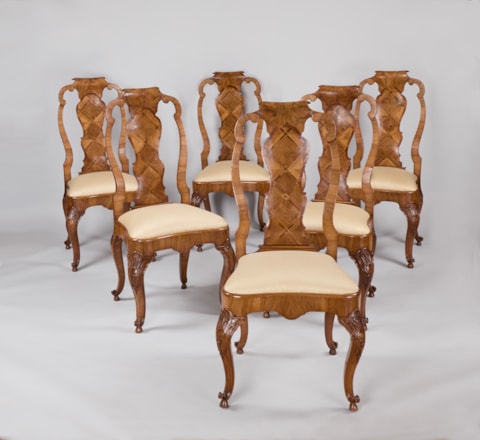Auricular Mirror
Venice, last quarter 17th century
attributed to Giacomo Piazzetta (Pederobba 1640 – 1705 Venice)
An Italian Auricular mirror frame carved out of walnut wood Venice
86,5 × 71 cm
Depicting the myth of Pan and Syrinx, decorated with a grotesque masque and rocaille ornaments and scenes of fighting satyrs and maenads between oak trees. These mythological creatures were regarded in the 17th century as symbols of decadence and sexual debauchery.
The Auricular frame appeared in Europe between the 1630s and 1680s, usually designed to show off the technical skill of the woodcarver or sculptor. Their origin therefore probably lies in the work of early 17th century goldsmiths. This frame is an excellent example of the Italian Auricular style with its favour for grotesque and monstrous forms.
Giacomo Piazzetta, sculptor and engraver, father of the painter Giambattista Piazzetta, is well known for his sculptured decoration in the Biblioteca della Basilica dei Santi Giovanni e Paolo in Venice. Frames carved with such virtuosity are very rare. With its expressive organic forms it is an outstanding example for the Venetian sculptured works of this age and has to be mentioned with creations of Andrea Brustolon (1662 – 1732).
Prov.: Private collection, Switzerland
The Auricular frame appeared in Europe between the 1630s and 1680s, usually designed to show off the technical skill of the woodcarver or sculptor. Their origin therefore probably lies in the work of early 17th century goldsmiths. This frame is an excellent example of the Italian Auricular style with its favour for grotesque and monstrous forms.
Giacomo Piazzetta, sculptor and engraver, father of the painter Giambattista Piazzetta, is well known for his sculptured decoration in the Biblioteca della Basilica dei Santi Giovanni e Paolo in Venice. Frames carved with such virtuosity are very rare. With its expressive organic forms it is an outstanding example for the Venetian sculptured works of this age and has to be mentioned with creations of Andrea Brustolon (1662 – 1732).
Prov.: Private collection, Switzerland





